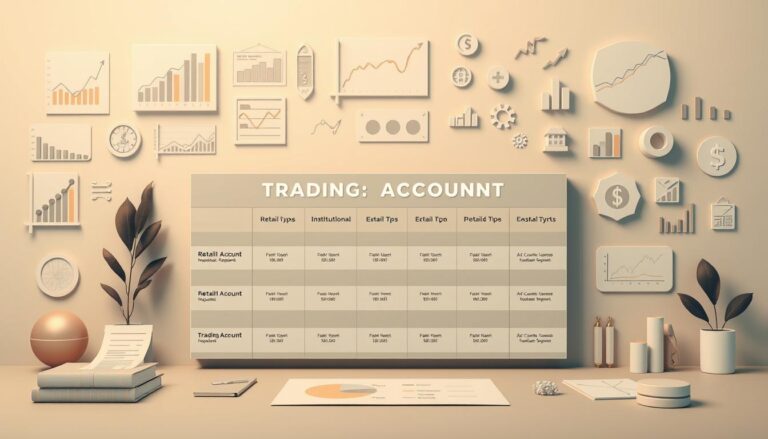Types of Stock Accounts: A Comprehensive Guide
Choosing the right financial tools can shape your long-term wealth. This guide explores how investment accounts help individuals grow their money through assets like stocks, bonds, or mutual funds. Whether saving for retirement, education, or general wealth-building, each option serves distinct goals.
A stock account acts as a gateway to financial markets. Brokerage platforms let users trade securities, while retirement-focused options like ISAs or pensions prioritize tax efficiency. Education savings plans, such as Junior ISAs in the UK, offer tailored benefits for future expenses.
Flexibility varies across these tools. Some allow quick access to money, while others lock funds for years in exchange for tax advantages. Understanding these differences ensures alignment with personal priorities—whether maximizing returns or minimizing liabilities.
This article breaks down common categories: standard trading platforms, retirement solutions, and education-oriented plans. It also covers niche programs for specific needs. By the end, readers will grasp how to match their investment strategy with the ideal account structure.
Exploring Various Types of Stock Accounts
Navigating financial markets starts with selecting the right platform for your goals. Brokerage accounts act as flexible hubs for buying and selling assets like stocks or ETFs. These tools cater to active traders and long-term investors alike, offering immediate access to funds.
Retirement-focused options, such as ISAs or pensions, prioritize tax efficiency over liquidity. Contributions often come with upfront deductions or tax-free growth. This makes them ideal for future planning.
Specialized plans serve niche needs. Junior ISAs help families save for education, while custodial versions let parents manage assets for minors. Ownership choices range from individual to joint setups.
Upcoming sections explore standard brokerage features, education savings strategies, and tax optimization. Matching these frameworks to personal objectives creates a clearer path toward financial growth.
Understanding Standard Brokerage Accounts

Standard brokerage accounts serve as foundational tools for building wealth through market participation. These platforms let users trade securities like stocks, bonds, and mutual funds, offering flexibility for both short-term trades and long-term strategies.
Cash vs. Margin: Core Differences
A cash account requires investors to use deposited funds for purchases. This limits risk but ensures no debt accumulation. In contrast, a margin account allows borrowing money from brokers to amplify buying power. While this boosts potential gains, it introduces interest expenses and higher risk if investments decline.
For example, purchasing $10,000 of shares in a cash account demands full payment upfront. With margin, an investor might borrow $5,000 to buy $15,000 worth of stock—potentially magnifying profits or losses.
Balancing Taxes and Costs
Dividends and interest earned in these accounts are taxed as ordinary income. Capital gains from selling assets also trigger income taxes, with rates depending on holding periods. Many brokers now offer $0 trading commissions, but fees for wire transfers or account closures may apply.
Investors should review fee schedules carefully. While early withdrawal penalties are rare outside retirement plans, unexpected charges can erode returns. Diversifying across ETFs or index funds helps manage risk while keeping expenses low.
Retirement Account Options and Strategies
Building a secure retirement requires aligning savings tools with tax-efficient strategies. Retirement accounts like Traditional IRAs and Roth IRAs offer distinct paths to grow wealth while managing liabilities. Employer-sponsored plans, such as 401(k)s, add another layer of flexibility for long-term goals.
Traditional IRA and Roth IRA Explained
A Traditional IRA lets investors deduct contributions from taxable income, reducing upfront taxes. Withdrawals during retirement are taxed as ordinary income. In contrast, a Roth IRA uses after-tax contributions but allows tax-free withdrawals if held for at least five years.
For 2023, both accounts share a $6,500 contribution limit ($7,500 for those 50+). Roth IRAs phase out for higher earners, while Traditional IRAs lack income caps but restrict deductibility at certain thresholds.
Employer-Sponsored 401(k) Plans
Employer 401(k) plans often include matching contributions—free money that accelerates growth. The 2023 contribution limit is $22,500 ($30,000 for ages 50+), with taxes deferred until withdrawal. Some employers also offer Roth 401(k) options for tax-free retirement income.
To maximize benefits:
- Prioritize employer matches to avoid leaving funds on the table
- Combine IRAs with 401(k)s to diversify tax treatment
- Review investment earnings annually to adjust allocations
Supplementing these accounts with taxable brokerage holdings or bonds can balance risk and liquidity. Tax-deferred growth remains a cornerstone of retirement planning, turning steady contributions into compounded wealth over decades.
Investment Accounts for Minors and Custodial Options

Preparing the next generation for financial independence starts early. Custodial tools allow adults to manage assets for children while teaching responsible money habits. These accounts balance growth potential with legal safeguards, ensuring funds support education or future milestones.
Custodial Brokerage Accounts (UGMA/UTMA)
UGMA and UTMA accounts let adults hold stocks, bonds, or cash for a child. The custodian controls investments until the minor reaches legal age—18 or 21, depending on location. Once transferred, the child gains full ownership, with no restrictions on how money is used.
These plans offer flexibility for education costs or other needs. However, withdrawals before transfer require proving expenses benefit the minor. Unlike 529 plans, funds aren’t limited to school-related uses.
Custodial IRA for Young Earners
Minors with earned income—like part-time jobs—can open a custodial IRA. Contributions grow tax-free, mirroring Roth IRA rules. For 2023, the limit is $6,500 or the child’s annual earnings, whichever is lower.
Starting early harnesses compound growth. A teen contributing $2,000 annually could amass over $500,000 by retirement. Parents should verify the child meets IRS income requirements and document earnings properly.
Key considerations when choosing custodial tools:
- Compare fees and investment options across platforms
- Discuss financial responsibility with older teens
- Align choices with long-term education or career goals
Education Savings and 529 Plans Overview

Families prioritizing future learning goals have specialized tools to manage costs. Education savings plans like 529s and Coverdell ESAs provide tax-advantaged growth for tuition, books, and other needs. These options help bridge the gap between rising college expenses and household budgets.
Balancing Flexibility and Limits
529 savings plans allow contributions up to £16,000 annually (UK equivalent) with tax-free withdrawals for qualified education expenses. They cover university costs, apprenticeships, and vocational training. Coverdell ESAs, though capped at £2,000 yearly, permit investments in stocks or mutual funds for broader growth potential.
Coverdell funds can also cover primary or secondary school fees—a perk 529s lack. However, unused Coverdell savings must be transferred or withdrawn by age 30, while 529s have no age limits.
Maximizing Tax-Free Growth
Withdrawals remain tax-free if used for qualified education expenses, including tuition, supplies, and room and board. For example, £10,000 withdrawn for college housing avoids taxes entirely. Non-educational uses trigger penalties plus income taxes on earnings.
Account owners retain control even if beneficiaries become adults. This allows adjustments if a child pursues non-academic paths. Starting early amplifies compound growth—a £200 monthly contribution at 6% interest grows to over £70,000 in 18 years.
ABLE Accounts and Specialized Investment Programs

Financial inclusivity takes center stage with specialized tools like ABLE accounts. Designed for individuals with disabilities, these programs offer tax-free growth on savings while protecting eligibility for government benefits like Medicaid. Unlike traditional plans, they prioritize accessibility over strict usage rules.
ABLE accounts shield assets from affecting means-tested aid. Most benefits cap personal savings at £20,000—exceeding this risks losing support. With ABLE, balances up to £85,000 in the UK remain exempt. This lets families build reserves for housing, education, or healthcare without penalties.
Eligibility requires disability onset before age 26. Applicants need medical documentation, like a GP letter confirming diagnosis. Annual contributions are capped at £12,300 (2023), with money used flexibly for disability-related expenses. Investment options mirror 529 plans, including stocks and bonds.
These programs differ from education-focused plans by allowing broader spending categories. While 529s limit withdrawals to school costs, ABLE funds cover transport, assistive tech, or job training. Both offer tax advantages, but ABLE’s higher asset thresholds better serve long-term security needs.
Key advantages over similar programs:
- No “use it or lose it” deadlines for withdrawals
- Lower impact on Universal Credit calculations
- Ability to switch beneficiaries within families
Tax Implications and Fee Structures in Investment Accounts

Managing investment costs requires understanding both visible fees and hidden tax impacts. Every account type carries unique expense structures, from trading commissions to annual maintenance charges. For example, Fidelity’s UK platform charges £10 per trade for stocks, while tax-advantaged retirement plans often have lower fees but stricter withdrawal rules.
Early withdrawals from pensions or ISAs can trigger income taxes plus a 25% penalty if under age 55. Taxable brokerage accounts avoid penalties but levy capital gains taxes on profits exceeding £12,300 annually. Savvy investors time withdrawals to stay below thresholds, preserving more savings.
Fee structures directly affect net returns. A £500 annual charge in a £50,000 portfolio reduces gains by 1% yearly—compounding into significant losses over decades. Tax-deferred accounts soften this blow by delaying income taxes, but high management fees still erode growth.
To minimize costs:
- Compare platforms like Fidelity or Vanguard for low trading fees
- Use ISAs for tax-free growth on UK investments
- Review statements quarterly to catch unexpected charges
FDIC-protected cash holdings offer safety but typically yield less than inflation. Balancing insured deposits with brokerage investments maintains liquidity while pursuing higher returns. Always consult a tax advisor before large withdrawals to avoid taxes penalties.
Tips for Effective Portfolio and Account Management

Building a resilient investment strategy requires more than just picking assets—it demands smart account oversight. Regular reviews and proactive adjustments help align holdings with evolving goals. Whether managing a brokerage account or retirement plan, balancing growth and risk ensures sustainable progress.
Diversification Strategies for Long-Term Growth
A diversified portfolio spreads risk across stocks, bonds, and mutual funds. Allocating 60% to equities and 40% to fixed-income assets is a common starting point. Younger investors might lean heavier on stocks for growth, while those nearing retirement often prioritize stability.
Rebalancing quarterly keeps allocations on track. For example, if tech stocks surge and dominate your portfolio, trimming them locks in gains and reduces exposure. Index funds or ETFs simplify diversification with low expenses, letting you mirror market performance without constant trading.
Monitoring Fees and Withdrawal Policies
Hidden fees quietly erode investment earnings. A 1% annual charge on a £100,000 portfolio costs £1,000 yearly—enough to fund a vacation. Compare platforms like Vanguard or Hargreaves Lansdown for competitive trading fees and transparent pricing.
Avoiding early withdrawal penalties requires planning. If emergency funds are needed, tap taxable accounts first. Retirement plans like ISAs or pensions often impose 25% penalties for premature access. Tools like robo-advisors automate fee tracking and suggest cost-cutting moves.
Case in point: A 60-year-old who rebalanced annually and negotiated lower fees saw 12% higher returns over a decade compared to a static portfolio. Small tweaks compound into major gains over time.
Your Path to Financial Success
Achieving long-term prosperity hinges on tailored investment approaches. From retirement vehicles like Roth IRAs to education-focused 529 plans, each tool serves unique goals. Selecting the right mix requires balancing growth potential, tax implications, and liquidity needs.
Brokerage platforms offer flexibility for active traders, while custodial setups help families prepare younger generations. Tax-advantaged options, such as pensions or ISAs, shield savings from unnecessary liabilities. Regularly reviewing contribution limits ensures you maximize annual allowances—key for compounding growth.
Diversifying across mutual funds, bonds, and other assets reduces risk while smoothing returns. Prioritize low-fee structures and consult a financial advisor to refine strategies. With careful planning, your money can work smarter across multiple accounts, paving the way for sustained success.





